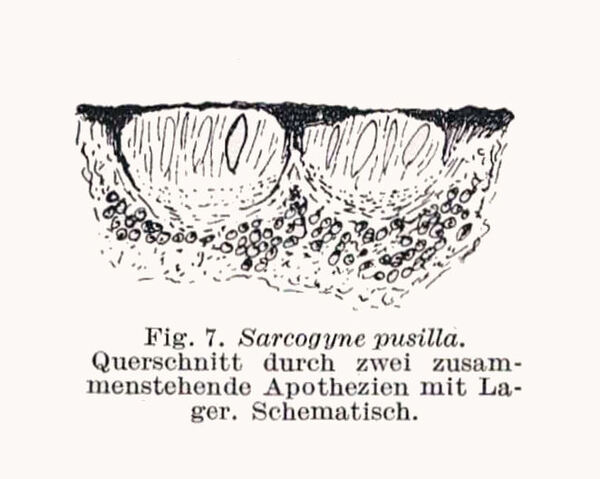Sarcogyne pusilla Anzi
Comm. Soc. Critt. Ital., 1, 3: 157, 1862.
Synonyms: Biatorella pusilla (Anzi) Zahlbr.; Polysporina pusilla (Anzi) Nimis
Description: Thallus crustose, not evident, developing inside the thalli of crustose lichens or the apothecia of Protoblastenia incrustans. Apothecia lecideine, black, round, dispersed, superficial, 0.15-0.5(-1) mm across, the disc mostly flat, with carbonized umbos or ridges or without carbonization, reddish when wet, the margin rugulose-furrowed. Proper exciple black and carbonized in outer part, brown-black to colourless within, 40-100 μm thick, continuous with the hypothecium; epithecium 10-25 μm high, dark brown; hymenium colourless, 80-120 μm high; paraphyses coherent (becoming lax in K), simple to sparingly branched, regularly septate, 2-3 μm thick, the apical cells unexpanded; hypothecium 100-150 μm thick, continuous with vegetative hyphae. Asci 100-200-spored, strongly thickened at apex, the apical dome K/I-, the outer coat K/I+ blue. Ascospores 1-celled, hyaline, ellipsoid to broadly ellipsoid, 4.5-6 x 2-3 μm. Photobiont probably absent, but the host thalli have chlorococcoid algae. Spot tests: thallus K-, C-, KC-, P-, UV-. Chemistry: without lichen substances.
Growth form: Lichenicolous fungus
Substrata: rocks
Reproductive strategy: mainly sexual
paras crustose lichens
Commonnes-rarity: (info)
Alpine belt: extremely rare
Subalpine belt: very rare
Montane belt: rather rare
Dry submediterranean belt: extremely rare
Humid submediterranean belt: extremely rare
Padanian area: absent
pH of the substrata:
1 2 3 4 5
Solar irradiation:
1 2 3 4 5
Aridity:
1 2 3 4 5
Eutrophication:
1 2 3 4 5
Poleotolerance:
0 1 2 3
Altitudinal distribution:
1 2 3 4 5 6
Rarity
absent
extremely rare
very rare
rare
rather rare
rather common
common
very common
extremely common
Loading data...
Occurrence data
Predictive map
Growth form: Lichenicolous fungus
Substrata: rocks
Reproductive strategy: mainly sexual
paras crustose lichens
Commonnes-rarity: (info)
Alpine belt: extremely rare
Subalpine belt: very rare
Montane belt: rather rare
Dry submediterranean belt: extremely rare
Humid submediterranean belt: extremely rare
Padanian area: absent
pH of the substrata:
| 1 | 2 | 3 | 4 | 5 |
Solar irradiation:
| 1 | 2 | 3 | 4 | 5 |
Aridity:
| 1 | 2 | 3 | 4 | 5 |
Eutrophication:
| 1 | 2 | 3 | 4 | 5 |
Poleotolerance:
| 0 | 1 | 2 | 3 |
Altitudinal distribution:
| 1 | 2 | 3 | 4 | 5 | 6 |
Rarity
absent
extremely rare
very rare
rare
rather rare
rather common
common
very common
extremely common
Loading data...
Occurrence data
Predictive map







